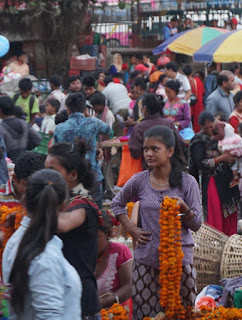Hindu
Diwali, The five-day festival of lights, which coincides with Hindu New Year,
is seen to be one of the most significant in the Indian culture.
Many people
celebrate the legend of Hindu God Rama and his wife Sita's returning to their
kingdom in northern India after being exiled following the defeat
of demon king Ravanna. The word itself means "series of lights"
and during the festival houses and shops are decorated with candles and lights.
This
is meant to represent light over darkness and the Hindu belief that good will
always triumph over evil. The
date of the festival is calculated according to the position of the moon and
the Hindu lunar calendar and is usually in October or November. The most
important day is today, I think.
Holiday in Patan
Early in the morning I stood on the roof to draw the prayer flags in the hazy light of the Kathmandu valley, the temple Swayambhunath gleaming gold on the top of the hill as a woman in a red sari struck her bells and the pigeons and crows called in the distance. I was worried, probably got up around 2 am, about all this climbing gear about how to get it up the mountain.
The dome at the base represents the entire world. When a person
awakes (represented by eyes of wisdom and compassion) from the bonds of the
world, the person reaches the state of enlightenment. The thirteen pinnacles on
the top symbolize that sentient beings have to go through the thirteen stages
of spiritual realizations to reach enlightenment or Buddhahood.
There is a large pair of eyes on each of the four sides of the
main stupa which represent Wisdom and Compassion. Swayambhunath is also known as the Monkey
Temple as there are holy monkeys living in the north-west parts of the
temple. For the Buddhist Newars, in
whose mythological history and origin myth as well as day-to-day religious practice
Swayambhunath occupies a central position.
For Tibetans and followers of Tibetan Buddhism, it is
second only to Boudha.
So my hotel, the Tibet Guest House, is run, it seems by Tibetans and has lots of prayer flags on the roof.
Swayambhunath in the distance.


























No comments:
Post a Comment